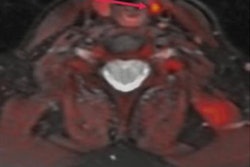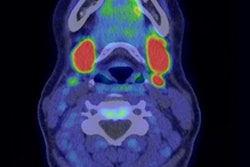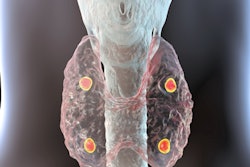F-18 fluorocholine (FCH) PET/CT appears to be an effective first-line imaging method in patients with primary hyperparathyroidism, according to a group of researchers in France.
The finding is from a study in which the technique successfully identified parathyroid adenomas, or benign tumors of the parathyroid glands, in patients who subsequently underwent surgical treatment, noted Elsa Bouilloux, MD, of the Centre Georges François Leclerc in Dijon, and colleagues.
“Our results confirm the good diagnostic performance of F-18 FCH-PET/CT as the first-line functional imaging method for the detection of pathological parathyroid glands in patients with [primary hyperparathyroidism],” the group wrote. The study was published October 24 in Academic Radiology.
Primary hyperparathyroidism (PHPT) is caused by excessive secretion of parathyroid hormone, most often due to a single parathyroid adenoma, and is generally diagnosed during routine laboratory tests, the authors explained. The only curative treatment is to remove the glands.
The combination of technetium-99m sestamibi (Tc-99m MIBI) SPECT/CT with cervical ultrasonography is the most widely used first-line preoperative imaging procedure, yet there is no clear consensus on the optimal imaging strategy, they added. With evidence growing that FCH-PET/CT may be a more sensitive method, the researchers aimed to provide more evidence on the use of the technique as a first-line approach.
The study included 80 patients with PHPT who underwent F-18 FCH-PET/CT between January 2018 and July 2022 and who then underwent surgery. The diagnostic performance of FCH PET/CT was compared with biopsy results obtained after surgery in a per-lesion and per-patient analysis.
According to the results, F-18 FCH-PET/CT revealed 95 positive foci in 77 out of 80 patients and was negative in three. A per-lesion analysis compared with biopsy results showed that there were 80 true positives on imaging, five true negatives, 11 false negatives, and eight false positives, giving the approach a sensitivity of 88% and a positive predictive value of 91%.
In a per-patient analysis, F-18 FCH-PET/CT correctly identified and located all pathological glands in 70% of patients, the researchers added. Finally, an improvement in postsurgical hyperparathyroidism symptoms was achieved in 67 of the patients (84%).
“Our results provide additional arguments supporting the use of FCH PET/CT as the first-line preoperative functional imaging technique in patients suffering from PHPT,” the group wrote.
Ultimately, compared with Tc-99m MIBI SPECT/CT, F-18 FCH-PET/CT offers a shorter scan time (about 90 minutes vs. at least 150 minutes), as well as significantly lower exposure to radiation, the researchers noted, and compared with neck ultrasound, F-18 FCH PET/CT identifies more hyperfunctioning glands.
On the other hand, disadvantages of the approach include its higher cost and lower availability, they wrote.
Nonetheless, the main objective of this study was to provide additional evidence that F-18 FCH-PET/CT could be an effective first-line imaging method in these patients, with the goal of eventually increasing its use in clinical practice.
“International clinical and radiological guidelines still do not mention FCH-PET/CT in the management of PHPT, or consider it as an alternative method,” the group noted.
The full study is available here.




















